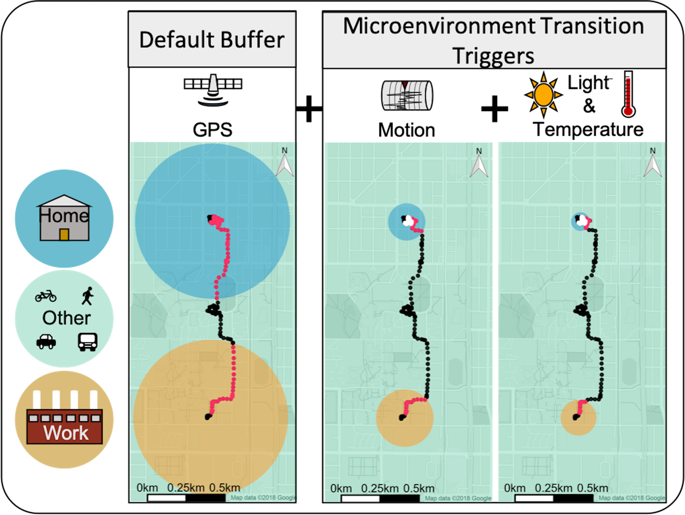当前位置:
X-MOL 学术
›
J. Expo. Sci. Environ. Epid.
›
论文详情
Our official English website, www.x-mol.net, welcomes your
feedback! (Note: you will need to create a separate account there.)
Dynamic classification of personal microenvironments using a suite of wearable, low-cost sensors.
Journal of Exposure Science and Environmental Epidemiology ( IF 4.1 ) Pub Date : 2020-01-14 , DOI: 10.1038/s41370-019-0198-2 Casey Quinn 1 , G Brooke Anderson 1 , Sheryl Magzamen 1 , Charles S Henry 2 , John Volckens 1, 3
Journal of Exposure Science and Environmental Epidemiology ( IF 4.1 ) Pub Date : 2020-01-14 , DOI: 10.1038/s41370-019-0198-2 Casey Quinn 1 , G Brooke Anderson 1 , Sheryl Magzamen 1 , Charles S Henry 2 , John Volckens 1, 3
Affiliation

|
Human exposure to air pollution is associated with increased risk of morbidity and mortality. However, personal air pollution exposures can vary substantially depending on an individual's daily activity patterns and air quality within their residence and workplace. This work developed and validated an adaptive buffer size (ABS) algorithm capable of dynamically classifying an individual's time spent in predefined microenvironments using data from global positioning systems (GPS), motion sensors, temperature sensors, and light sensors. Twenty-two participants in Fort Collins, CO were recruited to carry a personal air sampler for a 48-h period. The personal sampler was retrofitted with a GPS and a pushbutton to complement the existing sensor measurements (temperature, motion, light). The pushbutton was used in conjunction with a traditional time-activity diary to note when the participant was located at "home", "work", or within an "other" microenvironment. The ABS algorithm predicted the amount of time spent in each microenvironment with a median accuracy of 99.1%, 98.9%, and 97.5% for the "home", "work", and "other" microenvironments. The ability to classify microenvironments dynamically in real time can enable the development of new sampling and measurement technologies that classify personal exposure by microenvironment.
中文翻译:

使用一套可穿戴的低成本传感器对个人微环境进行动态分类。
人类暴露于空气污染会增加发病和死亡的风险。但是,个人空气污染暴露可能会因个人的日常活动方式以及居住和工作场所内的空气质量而有很大不同。这项工作开发并验证了一种自适应缓冲区大小(ABS)算法,该算法能够使用来自全球定位系统(GPS),运动传感器,温度传感器和光传感器的数据动态地将个人在预定义的微环境中花费的时间分类。科罗拉多州柯林斯堡的22名参与者被招募来进行48小时的个人空气采样。对个人采样器进行了GPS和按钮的改造,以补充现有的传感器测量值(温度,运动,光线)。该按钮与传统的时间活动日志结合使用,以记录参与者何时位于“家”,“工作”或“其他”微环境中。ABS算法可预测每个微环境所花费的时间,其中“家”,“工作”和“其他”微环境的中位准确度为99.1%,98.9%和97.5%。实时动态地对微环境进行分类的能力可以开发新的采样和测量技术,从而可以按微环境对个人暴露进行分类。ABS算法可预测每个微环境所花费的时间,其中“家”,“工作”和“其他”微环境的中位数准确度为99.1%,98.9%和97.5%。实时动态地对微环境进行分类的能力可以开发新的采样和测量技术,从而可以按微环境对个人暴露进行分类。ABS算法可预测每个微环境所花费的时间,其中“家”,“工作”和“其他”微环境的中位数准确度为99.1%,98.9%和97.5%。实时动态地对微环境进行分类的能力可以开发新的采样和测量技术,从而可以按微环境对个人暴露进行分类。
更新日期:2020-01-14
中文翻译:

使用一套可穿戴的低成本传感器对个人微环境进行动态分类。
人类暴露于空气污染会增加发病和死亡的风险。但是,个人空气污染暴露可能会因个人的日常活动方式以及居住和工作场所内的空气质量而有很大不同。这项工作开发并验证了一种自适应缓冲区大小(ABS)算法,该算法能够使用来自全球定位系统(GPS),运动传感器,温度传感器和光传感器的数据动态地将个人在预定义的微环境中花费的时间分类。科罗拉多州柯林斯堡的22名参与者被招募来进行48小时的个人空气采样。对个人采样器进行了GPS和按钮的改造,以补充现有的传感器测量值(温度,运动,光线)。该按钮与传统的时间活动日志结合使用,以记录参与者何时位于“家”,“工作”或“其他”微环境中。ABS算法可预测每个微环境所花费的时间,其中“家”,“工作”和“其他”微环境的中位准确度为99.1%,98.9%和97.5%。实时动态地对微环境进行分类的能力可以开发新的采样和测量技术,从而可以按微环境对个人暴露进行分类。ABS算法可预测每个微环境所花费的时间,其中“家”,“工作”和“其他”微环境的中位数准确度为99.1%,98.9%和97.5%。实时动态地对微环境进行分类的能力可以开发新的采样和测量技术,从而可以按微环境对个人暴露进行分类。ABS算法可预测每个微环境所花费的时间,其中“家”,“工作”和“其他”微环境的中位数准确度为99.1%,98.9%和97.5%。实时动态地对微环境进行分类的能力可以开发新的采样和测量技术,从而可以按微环境对个人暴露进行分类。









































 京公网安备 11010802027423号
京公网安备 11010802027423号